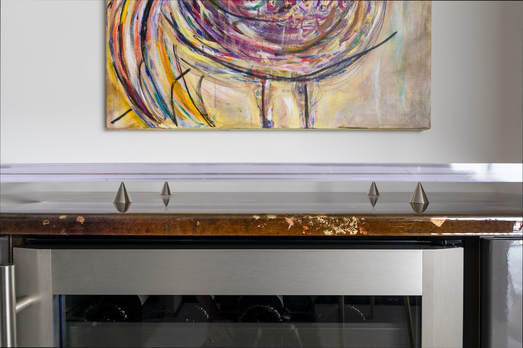|
This post has a seemingly superficial (pun #1) title which also happens to be quite profound (pun #2). Today I'd like to share my experiences with epoxy resin and a countertop design for a custom wine and liquor cabinet. Those who have worked with epoxy resin know that if you choose the wrong materials, resignation is often par for the course. This all started when my husband Fabio and I moved to our brand new Miami condo. We wanted to create a custom-designed wine and liquor cabinet. We have complementary skills and together we make a great team. He’s very technical, mechanically inclined and a tinkerer by heart; I’m highly creative, spontaneous and eager to project my emotions in colorful paintings. This is the final result we came up with... Here's a more detailed view of the countertop itself... The base of the wine and liquor cabinet uses commercial parts and we chose a neutral gray color to match the décor of our condo. From the very beginning I wanted to have a custom countertop, something that I could use as canvas to play with. I decided to use MDF as the material for the countertop with the idea of finishing it with epoxy resin. As an artist I had previous experience with resin and over the years used it extensively in my designs. When I was living in my home country Brazil I was forced to use heavy-duty industrial adhesive epoxy resins to coat my paintings. I also had to wear a mask and heavy gloves due to the strong smell and caustic nature of the product. My husband had a similar experience in his projects. So when I moved to the US in 2010 I tried to find something better, more appropriate for an artist. I tried a couple of resins that were sold in arts stores but the smell remained an issue. Then we came across Art Resin and ordered a kit. The product we ordered was much easier to use even though the formula at that time was different from today’s product. The strong smell was gone and even though we still wear gloves, the product is definitely less caustic than the industrial formulas. The resin is quite forgiving as long as you mix it properly, level the work, and take your time to spread it uniformly. We have a propane torch that has proven invaluable to remove bubbles and make the resin perfectly glossy. Over time, I’ve experimented with different looks, and today I sometimes apply the resin only to a portion of the canvas or don’t even torch it for a more distressed look. I’ve also used paint rollers for a very light and irregular coat over acrylic paint. Back to the wine and liquor cabinet, the 1-inch MDF was cut to size, had its edges slightly rounded and I got to work. I decided to spray alcohol-based aniline dye over the MDF using a mix of light and dark colors. The idea was to have different hues showing through like clouds. Once the dye dried, I coated the piece with satin varnish and applied gold leaf and paint (brushed and sprayed) to achieve the look I was after. We applied three coats of resin, sanding in between, per the instructions, to achieve a deeper gloss and highlight the design elements. The photo below shows a detail of the design applied to the countertop. It also shows two UFO's (Unidentified Fancy Objects) whose function will become clear shortly... After the resin cured, we attached the MDF countertop to the base cabinets, looked at each other and said, “Hmmm, there is something missing”. The something my engineer husband came up with was a rectangular sheet of thick acrylic the same size of the countertop and floating above it, supported by four conical supports (now you know what they are for). To the tune of “now I know why I got that engineering degree” my husband calculated how close to position the supports and yet avoid excessive bending to give a floating look to the finished piece. But Wait, There's More! The floating acrylic lies against the wall where he built-in an LED tape light—the light shines through the edges of the acrylic when we turn it on. This was a project that evolved organically and one we’re extremely happy with. Art Resin is definitely our go-to resin supplier, and I’m now planning my new project with their resin: a very thick (3- to 4-inch) multi-layered painting. But this is a subject for another post. You can see ArtResin's Facebook post on this work here.
0 Comments
|
Rosangela LoschiRosangela projects her emotions and feelings in colorful and fluid paintings that evoke optimism and eagerness for life. ArchivesCategories |





 RSS Feed
RSS Feed